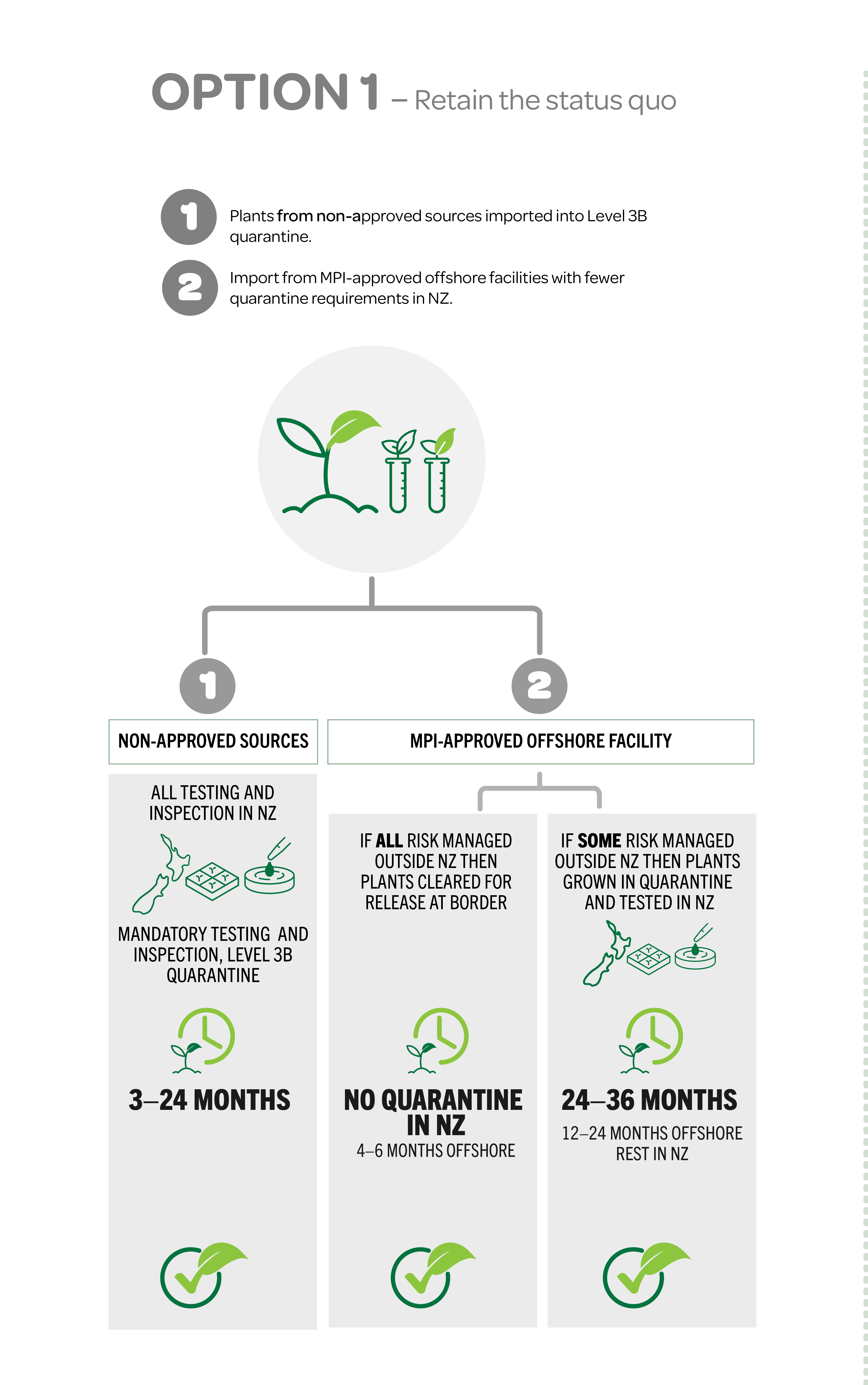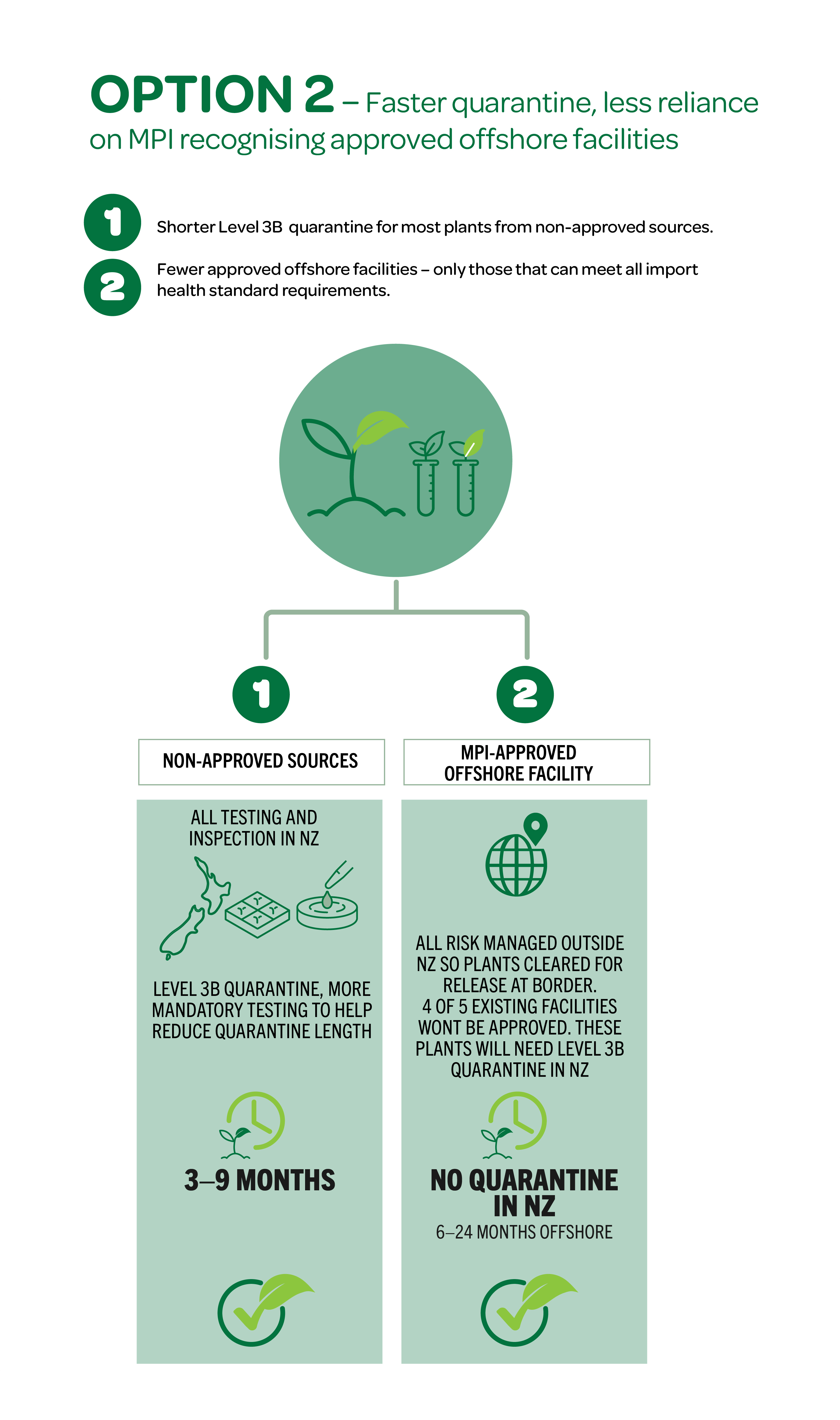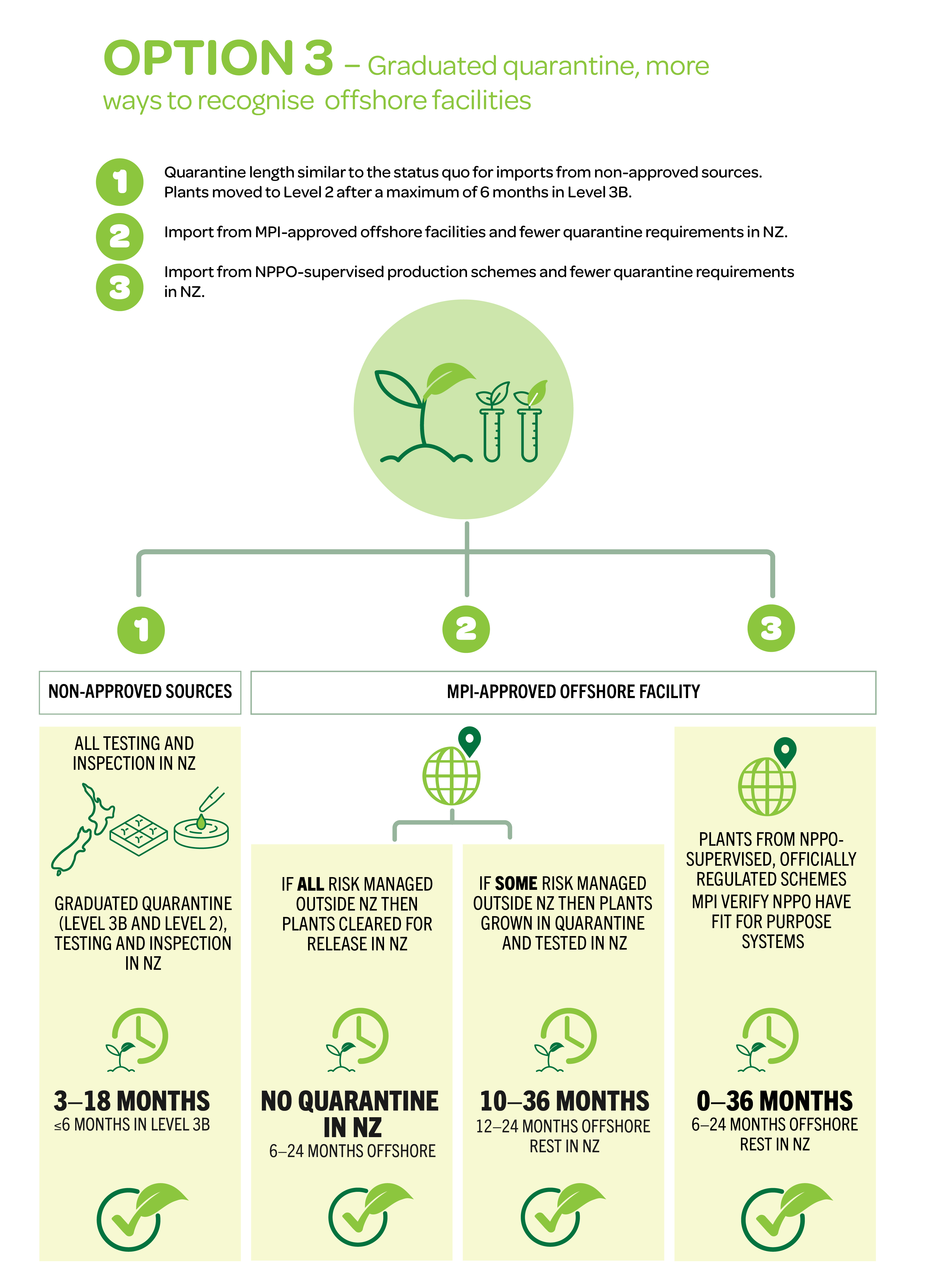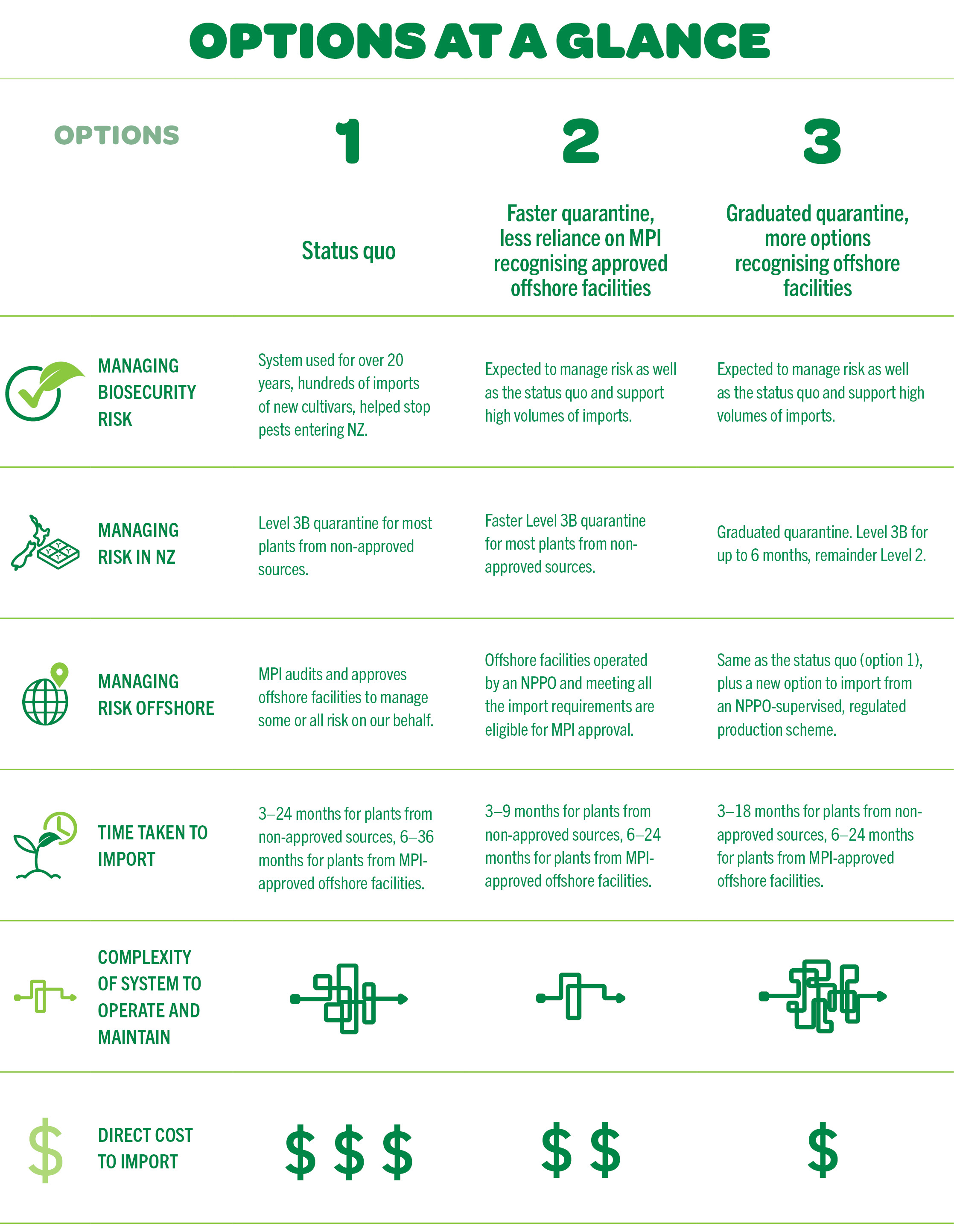Update – 23 October 2024
Consultation extended
The Ministry for Primary Industries has extended the length of consultation for proposed options for importing food and fibre plants for planting until 5pm on 31 March 2025.

The Ministry for Primary Industries has extended the length of consultation for proposed options for importing food and fibre plants for planting until 5pm on 31 March 2025.
The Ministry for Primary Industries (MPI) is consulting on proposed changes to options for importing food and fibre plants for planting.
We want to support New Zealand’s food and fibre industries by speeding up imports while maintaining our existing level of biosecurity risk management. On this page, we summarise the options for import and discuss the pros and cons.
Alongside the status quo, we’ve developed 2 options for improving the system. We want your feedback on:
This consultation only considers options for food and fibre plants. We will consult on how to improve imports for other types of plants, and seeds, later.
We're receiving submissions on this consultation from 21 October until 5pm on 31 March 2025.
This page and our FAQ document gives you more information about our proposals. Full details are in the consultation documents.
FAQs on improving the system for importing food and fibre plants for planting [PDF, 448 KB]
Proposal to improve the efficiency of imports of food and fibre plants for planting [PDF, 497 KB]
Appendix: Proposal to improve the efficiency of imports of food and fibre plants for planting [PDF, 584 KB]
We haven’t ruled out keeping the status quo. This has helped keep pests out of New Zealand while supporting imports of high volumes of plants from throughout the world for over 20 years.
It has allowed plants to be imported from MPI-approved offshore facilities with less quarantine and reduced costs, by recognising offshore procedures used to reduce biosecurity risk. However, we believe we could improve efficiency while managing risk as well as we do now under the status quo. The change options present 2 possible ways to do this.

Download option 1 infographic [JPEG, 2.1 MB]
Show/hide long description
This graphic shows the pathways that are used/operate under the existing system – the status quo. It is headed 'Option 1, retain the status quo'. It then describes 2 pathways, numbered '1' and '2'. The numbers appear in grey circles. Alongside the number 1 are the words 'Plants from non-approved sources imported into Level 3B quarantine'. Alongside the number 2 are the words 'Import from MPI-approved offshore facilities with fewer quarantine requirements in NZ'.
Underneath is a light-coloured circle, with icons, showing a young seedling beside 2 test tubes also showing seedlings growing from them.
Two grey lines emerge from the bottom of this circle and split into 2, giving more details about the 2 pathways.
The information is in shaded rectangle boxes and uses a variety of icons to support the text.
Under the number 1, there is a boxed heading that says 'Non-approved sources'. The box says "All testing and inspection in NZ. Mandatory testing and inspection, Level 3B quarantine." It shows this method may take between 3 and 24 months.
Under the number 2, are 2 shaded rectangle boxes under a boxed heading that says 'MPI-approved offshore facility'. The first box says "If all risk managed outside NZ, then plants cleared for release at the border. No quarantine in NZ". It shows this method may take between 4 and 6 months offshore.
The second shaded rectangle box says "If some risk managed outside NZ then plants grown in quarantine and tested in NZ". It shows this method may take between 24 and 36 months – between 12 and 24 months in NZ and the rest offshore.
At the bottom of all 3 rectangle boxes is the same symbol – a green-coloured icon that is part leaf, part tick, inside a dark green circle.
[End description]
This option would place more emphasis on managing risk in New Zealand. It would reduce the current reliance on Biosecurity New Zealand officially recognising measures used at MPI-approved offshore facilities. With prior agreement from Biosecurity New Zealand, results of tests from any non-approved source could be recognised, subject to offshore NPPO certification. This would reduce duplication of tests that are done offshore when importing from non-approved sources.
It would help simplify the process for developing import health standards, enabling Biosecurity New Zealand to deliver and review more standards, faster.
All plants from non-approved sources would need Level 3B quarantine. We would rely more on laboratory testing to find key pests and less on inspecting plants for signs of disease, especially to find pests that take a long time to cause visible disease symptoms.
In most cases this should let us reduce quarantine length and release plants in 9 months or less. This would reduce import costs and speed up access to new plants.
We would only approve offshore facilities that are supervised by a National Plant Protection Organisation (NPPO) and that can apply all import requirements.
This would mean that only one of the existing 5 offshore facilities would be approved (this facility exports potato plants to New Zealand). The other 4 facilities would no longer be approved – plants from these facilities would need Level 3B quarantine (as above).

Download option 2 infographic [JPEG, 2.23MB]
Show/hide long description
This graphic shows the pathways that would operate under Option2. It is headed 'Option 2: Faster quarantine in New Zealand with less reliance on MPI-recognised offshore procedures'. It then describes 2 pathways, numbered '1' and '2'. The numbers appear in dark-green circles. Alongside the number 1 are the words 'Shorter Level 3B quarantine for most plants from non-approved sources'. Alongside the number 2 are the words 'Fewer approved offshore facilities only those that can meet all import health standard requirements'.
Underneath is a green-shaded circle, with icons, showing a young seedling beside 2 test tubes also showing seedlings growing from them.
Two green lines emerge from the bottom of this circle and split into 2, giving more details about the 2 pathways.
The information is in shaded rectangle boxes and uses a variety of icons to support the text.
Under the number 1, there is a boxed heading that says 'Non-approved sources'. The box says "All testing and inspection in NZ. Level 3B quarantine, more mandatory testing to help reduce quartine length." It shows this method may take between 3 and 9 months.
Under the number 2, is a shaded rectangle box under a boxed heading that says 'MPI-approved offshore facility'. The box says "All risk managed outside NZ, so plants cleared for release at the border. Four of 5 existing facilities won't be approved. These plants will need Level 3B quarantine in NZ. No quarantine in NZ". It shows this method may take between 6 and 24 months offshore.
At the bottom of the rectangle boxes is the same symbol – a green-coloured icon that is part leaf, part tick, inside a dark green circle.
[End description]
This would be more like the status quo than Option 2. Plants would still be imported from non-approved sources and from approved offshore sources. Approved sources would include MPI-approved offshore facilities and NPPO-supervised, officially regulated production schemes.
This option would help reduce duplication of offshore testing, recognise more offshore production schemes, and reduce time needed in Level 3B quarantine.
Plants from non-approved sources would initially need Level 3B quarantine but would be moved to Level 2 after testing for key pests. Total quarantine length would be similar to the status quo, with a target maximum of 6 months in Level 3B (and the rest in Level 2).
Plants from approved sources would either be released when they arrive in New Zealand (if all import procedures are applied offshore), or would need Level 1, 2, or 3A quarantine. The length and level of quarantine would depend on what risks are managed offshore and may differ between facilities.

Download option 3 infographic [JPEG, 2.2MB]
Show/hide long description
This graphic shows the pathways that would operate under Option 3. It is headed 'Option 3: Graduated quarantine, more ways to recognise offshore procedures'. It then describes 3 pathways, numbered '1' and '2' and '3'. The numbers appear in green circles. Alongside the number 1 are the words 'Quarantine length similar to the status quo for imports from non-approved sources. Plants moved to Level 2 after a maximum of 6 months in Level 3B'. Alongside the number 2 are the words 'Import from MPI-approved offshore facilities and fewer quarantine requirements in NZ'. Alongside the number 3 are the words'Impoprt from NPPO-supervised production schemes and fewer quarantine requirements in NZ'.
Underneath the numbers and text is a green-shaded circle, with icons, showing a young seedling beside 2 test tubes also showing seedlings growing from them.
Three lines emerge from the bottom of this circle and split into 3, giving more details about the 3 pathways.
The information is in shaded rectangle boxes and uses a variety of icons to support the text.
Under the number 1, there is a boxed heading that says 'Non-approved sources'. The box says "All testing and inspection in NZ. Graduated quarantine (Level 3B and Level 2), testing and inspection in NZ." It shows this method may take between 3 and 18 months with up to 6 months in Level 3B.
Under the number 2 and 3, are 3 shaded rectangle boxes under a boxed heading that says 'MPI-approved offshore facility'. The first box says "If all risk managed outside NZ, then plants cleared for release in NZ. No quarantine in NZ". It shows this method may take between 6 and 24 months offshore.
The second shaded rectangle box says "If some risk managed outside NZ then plants grown in quarantine and tested in NZ". It shows this method may take between 10 and 36 months – with between 12 and 24 months offshore and the rest in NZ.
The third shaded rectangle box says "Plants from NPPO-supervised, officially regulated schemes. MPI verify NPPO have fit-for-purpose systems'. It shows this method may take between zero and 36 months – with between 6 and 24 months offshore and the rest in NZ.
At the bottom of all 4 rectangle boxes is the same symbol – a green-coloured icon that is part leaf, part tick, inside a dark green circle.
[End description]

Download 'Options at a glance' infographic [JPEG, 925KB]
Show/hide long description
This infographic shows the key points for each option. It is titled 'options at a glance'. Under the tile are the numbers 1, 2, and 3. It says 1 is the status quo, 2 is faster quarantine, less reliance on MPI recognising approved offshore facilities, and 3 is graduated quarantine, more options recognising offshore facilities.
Down the left side of the infographic are some icons alongside some topics. For each topic, a statement appears under each of the option numbers – 1, 2, and 3.
The first topic is 'managing biosecurity risk'.
Under option 1 it says 'system used for over 20 years, hundreds of imports of new cultivars, helped stop pests entering NZ'.
Under option 2 it says 'expected to manage risk as well as the status quo and support high volumes of imports'.
Under option 3 it says 'expected to manage risk as well as the status quo and support high volumes of imports'.
The next topic is 'managing risk in NZ'.
Under option 1 it says 'Level 3B quarantine for most plants from non-approved sources'.
Under option 2 it says 'Faster Level 3B quarantine for most plants from non-approved sources'.
Under option 3 it says 'Graduated quarantine. Level 3B for up to 6 months, remainder Level 2'.
The next topic is 'managing risk offshore'.
Under option 1 it says 'MPI audits and approves offshore facilities to manage some or all risk on our behalf'.
Under option 2 it says 'offshore facilities operated by an NPPO and meeting all the import requirements are eligible for MPI approval'.
Under option 3 it says 'same as the status quo (option 1) plus a new option to import from an NPPO-supervised, regulated production scheme'.
The next topic is 'time taken to import'.
Under option 1 it says '3 to 24 months for plants from non-approved sources, 6 to 36 months for plants from MPI-approved offshore facilities'.
Under option 2 it says '3 to 9 months for plants from non-approved sources, 6 to 24 months for plants from MPI-approved offshore facilities'.
Under option 3 it says '3 to 18 months for plants from non-approved sources, 6 to 24 months for plants from MPI-approved offshore facilities'.
The next topic is 'complexity of system to operate and maintain'.
Under each option is a line diagram to visually represent the process importers need to follow for each option. The line diagrams show that option 2 is the least complex, option 3 is the most complex and option 1 is moderately complex.
The next topic is 'direct cost to import'.
Under each option are dollar signs to represent the relative cost for each. Option 1 has 3 dollar signs, option 2 has 2 dollar signs, and option 3 has 1 dollar sign.
[End description]
We assessed the feasibility of each option and compared it against the status quo using 5 criteria.
Our initial evaluation of options showed that Option 2 (faster quarantine in New Zealand with less reliance on MPI-recognised offshore procedures) would deliver the greatest overall benefits. We expect that this evaluation may change as a result of this consultation.
To help you understand the options, and our evaluation, we’ve summarised key features, benefits, and drawbacks of each option in a document.
Summary comparison of options [PDF, 132 KB]
We are happy to discuss what we’re proposing at any time during the consultation. You can give us feedback in several ways. Choose the methods that suits you best.
We must get your feedback by 5pm on 31 March 2025.
Complete our online survey – Survey Monkey
Email a submission to plantimports@mpi.govt.nz
To attend, email us and we’ll get back to you with details. Email your request to plantimports@mpi.govt.nz
To arrange a call, email plantimports@mpi.govt.nz
We will consider all feedback and use it to help us decide how best to manage risk from imported food and fibre plants for planting. We are committed to ensuring we consider all feedback and are happy to communicate with you in your preferred way (for example, in workshops or by phone) as needed to help develop our preferred option, identify implementation plans and ensure a smooth transition to any new system. Updates to import health standards will involve the usual and separate consultation process that is required by the Biosecurity Act (1993).
Note that all, part, or a summary of your submission may be published on this website. Most often this happens when we issue a document that reviews the submissions received.
People can also ask for copies of submissions under the Official Information Act 1982 (OIA). The OIA says we must make the content of submissions available unless we have good reason for withholding it. Those reasons are detailed in sections 6 and 9 of the OIA.
If you think there are grounds to withhold specific information from publication, make this clear in your submission or contact us. Reasons may include that it discloses commercially sensitive or personal information. However, any decision MPI makes to withhold details can be reviewed by the Ombudsman, who may direct us to release it.






MPI uses cookies to improve your experience on our site. By using our website, you accept our use of cookies.
